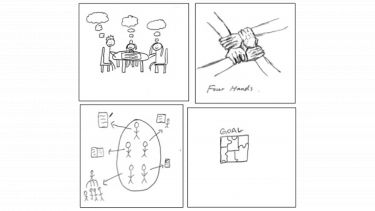"isquares": Conceptions of group work
A key project within the Libraries and Information research group.
Investigator: Pam McKinney
The impetus for this project was my interest in what students think about group work and how they work with each other in formally assessed and also casual group work situations.
In order to research this complex topic I have adopted the "Draw and Write" methodology first designed by Jenna Hartel from the University of Toronto to investigate student conceptions of information. http://www.isquares.info.
Students are asked to create a drawing on a square piece of paper (10cm x 10cm) called an "isquare" that describes or shows their conception of a phenomena, in this case their experience of group work. They then are asked to write a brief description on the other side of the piece of paper of what their drawing represents. This unusual data collection methodology leads to the creation of rich qualitative data that gives us as educators an interesting insight into what students think about group work. This builds on my previous research analysing student’s reflective writing about their experiences of working in a group.
Captions left to right, top to bottom:
- Figures shown working together round a desk. One figure denoted as "leader" through the inclusion of a crown.
- Four hands showing conceptions of strength through working together.
- Individuals contribute in different ways to the group.
- Group work is a puzzle.
The analysis of the isquares followed a procedure designed by Hartel (2014) including the following 3 modes:
- Compositional interpretation as defined by Engelhardt (2002),
- Content analysis of the drawings
- Thematic analysis of the text and drawings
The classification and analysis of the drawings has been undertaken in partnership with an undergraduate student who was recruited through the SURE (Sheffield Undergraduate Research Experience) scheme. A feature of this research methodology is the relative ease with which multiple researcher perspectives can contribute to the overall analysis of the data.
The findings from the project were reported at the University of Sheffield Learning and Teaching conference and also at the SURE showcase event in 2016. You can see the presentation here and a poster here. An article reporting the results is in preparation: contact p.mckinney@sheffield.ac.uk for more information.
References
Hartel (2014) An arts-informed study of information using the draw-and-write technique. Journal of the Association for Information Science & technology 65 (7)
Engelhardt, Y. (2002). The language of graphics: A framework for the analysis of syntax and meaning in maps, charts and diagrams. (Unpublished doctoral dissertation). Institute for Logic, Language and Computation, University of Amsterdam, The Netherlands.

